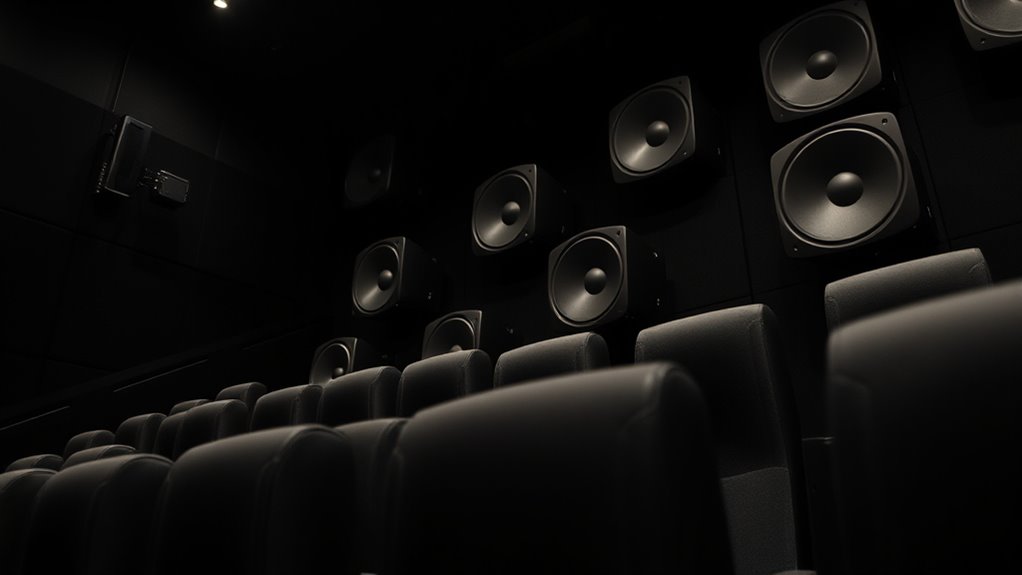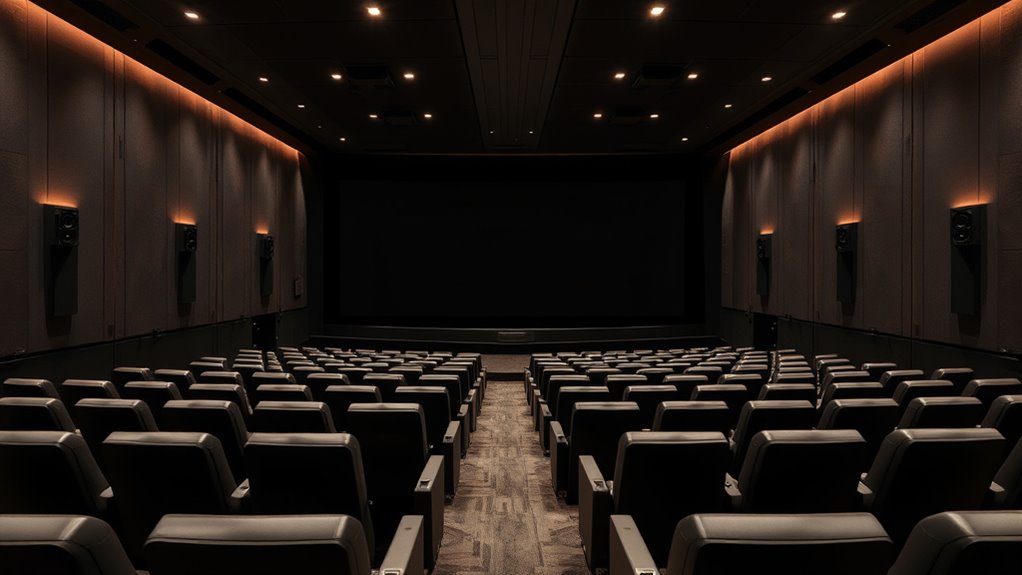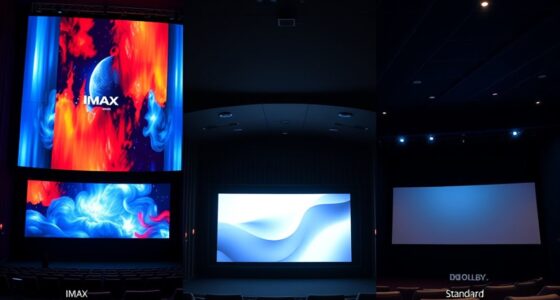In-theater immersive sound systems use advanced calibration and object-based audio formats like Dolby Atmos and DTS:X to create a 3D sound environment around you. You’ll hear sounds move overhead, around, and behind you, making the experience feel lifelike and engaging. Precise calibration guarantees each speaker delivers accurate sound levels and timing, enhancing clarity and depth. If you want to understand how these systems transform your movie experience, explore further to discover their technology and benefits.
Key Takeaways
- In-theater immersive sound systems utilize advanced formats like Dolby Atmos and DTS:X to create a three-dimensional audio environment.
- They involve precise calibration of speakers and use specialized microphones to ensure accurate sound placement and timing.
- These systems position sound objects in a 3D space, allowing sounds to move overhead and around the audience for heightened realism.
- Proper calibration eliminates echoes, dead spots, and uneven sound distribution, providing a consistent experience across all seating areas.
- Evolving technology enhances audio precision and immersion, transforming traditional cinemas into dynamic, lifelike cinematic environments.

Ever wondered what makes a movie truly immersive? It all comes down to the sound system. When you’re in a theater, you expect the audio to surround you, pulling you into the story and making every explosion, whisper, and musical note feel real. That’s where sound system calibration and immersive audio formats come into play. Proper calibration is vital because it ensures every speaker in the theater produces sound at the right levels and timing, creating a seamless and balanced soundscape. When done correctly, calibration eliminates echoes, dead spots, and uneven audio, so you experience a uniform sound environment no matter where you sit.
Immersive audio formats are the backbone of modern in-theater sound systems. These formats, like Dolby Atmos and DTS:X, go beyond traditional surround sound by adding height channels and object-based audio. Instead of just speakers around you, these formats place sound objects in a 3D space, allowing sounds to move dynamically around and above you. This creates a sense of depth and realism that standard surround sound can’t match. For example, if a helicopter flies overhead in the movie, you actually feel it above your head, not just behind or beside you. This level of precision makes you feel like you’re inside the scene rather than just watching it on a screen.
To achieve this, theaters use advanced calibration techniques, including specialized microphones and software, to fine-tune each speaker. This process ensures that each sound source is aligned perfectly in the digital space, preserving the intended directionality and intensity. When calibration is executed properly, the sound feels natural and consistent, no matter where you’re seated in the theater. It’s a meticulous process that involves measuring sound levels, adjusting delays, and balancing frequencies, all to deliver a cohesive audio experience. Additionally, the contrast ratio of the projection system can greatly influence how immersive and dynamic the visual experience feels, complementing the high-quality sound.
As technology advances, immersive audio formats continue to evolve, offering even more precise and engaging sound experiences. They’re designed to work with high-quality speakers and sophisticated calibration systems, transforming ordinary movies into cinematic adventures. When you step into a theater with a properly calibrated sound system and immersive audio formats, you’re not just watching the film—you’re experiencing it. Every sound is crafted to evoke emotion, heighten tension, and draw you deeper into the story. That’s the power of a well-calibrated, immersive sound system, making your movie experience unforgettable.
Frequently Asked Questions
How Do Immersive Sound Systems Differ From Traditional Surround Sound?
Immersive sound systems differ from traditional surround sound by creating a richer, more realistic sound field depth. You’ll notice sounds come from all directions, including above, thanks to strategic speaker placement that surrounds you completely. Unlike conventional setups, immersive systems use advanced speaker arrangements to produce a three-dimensional experience, making you feel like you’re right in the middle of the action, not just hearing it from the sides.
What Are the Installation Requirements for In-Theater Immersive Sound Setups?
You need a spacious, well-ventilated room with proper acoustic treatments like diffusers and absorbers to prevent sound reflections. Make certain the system is correctly calibrated with precise calibration procedures, including microphone placement and equalization, for ideal sound quality. You’ll also require sturdy mounting points for speakers and a compatible audio processor. Properly set up, these requirements ensure immersive sound experiences that truly envelop your audience.
Can Home Theaters Replicate Professional Immersive Sound Experiences?
Did you know that most home theaters can achieve immersive sound with proper setup? You can replicate professional experiences by carefully calibrating your speakers and optimizing acoustic treatment. Speaker calibration ensures balanced sound, while acoustic treatment minimizes echoes and improves clarity. With these steps, your home theater can deliver rich, immersive audio that rivals commercial theaters, making every movie night more engaging and cinematic.
What Maintenance Is Needed to Keep Sound Systems Optimal?
To keep your sound system ideal, you should regularly perform calibration procedures to guarantee balanced sound output. Check and adjust speaker alignment to prevent sound distortion and ensure proper positioning. Keep your equipment clean and free of dust, and update firmware when available. Periodically inspect cables and connections for wear or loose contacts. Doing these simple maintenance steps helps maintain high-quality sound and prolongs your system’s lifespan.
Are There Any Common Technical Issues With Immersive Theater Sound Systems?
You might face common technical issues like calibration challenges and speaker alignment problems in immersive theater sound systems. These issues can cause uneven sound distribution, reduced clarity, or delays. Regular checks and adjustments are essential to fix calibration and guarantee speakers are properly aligned. Staying proactive helps prevent sound disruptions, maintaining a prime immersive experience for your audience. Proper maintenance and troubleshooting keep your system performing at its best.
Conclusion
Think of in-theater immersive sound systems as the orchestra conductor guiding your movie experience. They weave sounds around you, transforming a simple film into a symphony that surrounds your senses. By embracing these advanced audio technologies, you’re stepping into a world where every whisper, explosion, and melody feels like it’s happening right beside you. So, next time you watch a movie, let these sound systems be your personal ticket to a truly enthralling, three-dimensional adventure.








